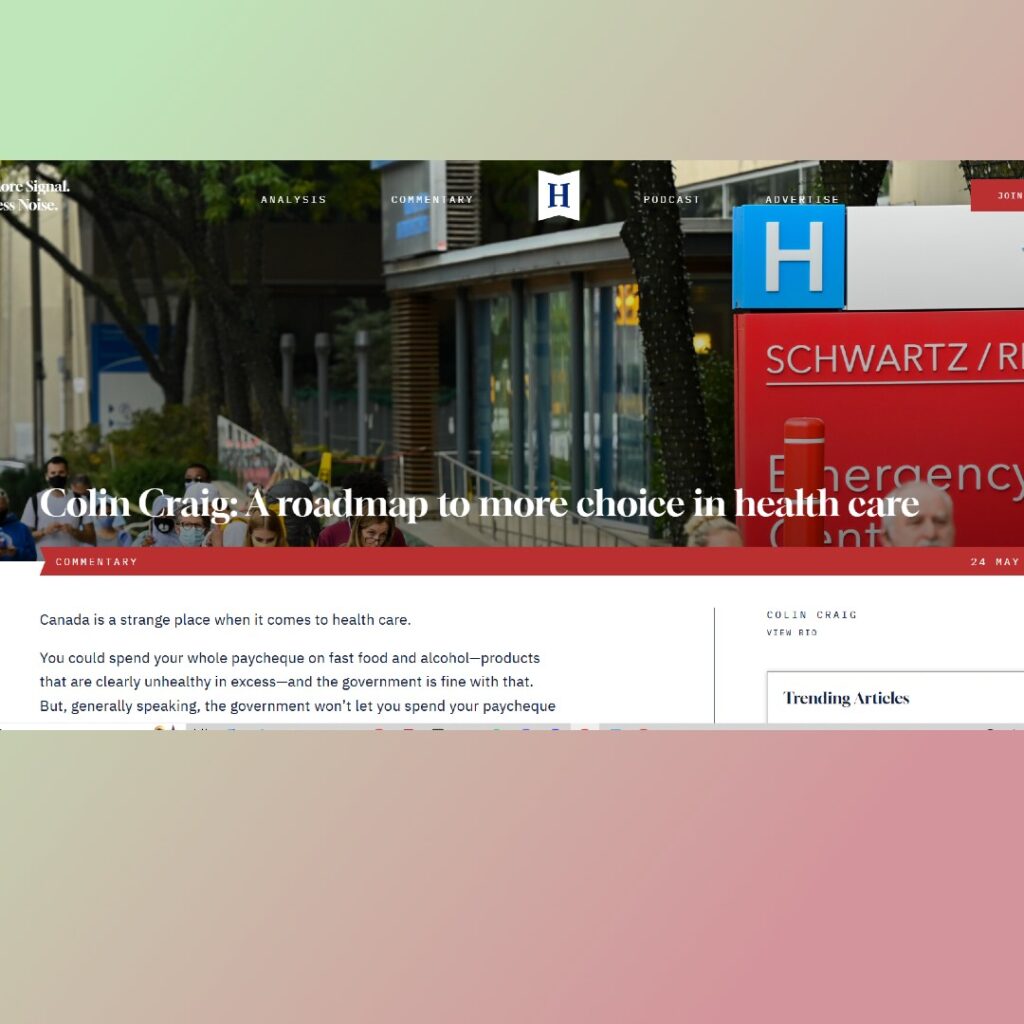THE HUB COLUMN: A roadmap to more choice in health care

Canada is a strange place when it comes to health care.
You could spend your whole paycheque on fast food and alcohol—products that are clearly unhealthy in excess—and the government is fine with that. But, generally speaking, the government won’t let you spend your paycheque on private surgery at a local clinic in order to help your body—a hip operation, knee surgery, etc.
Ottawa has even cut funding to provinces that allow patients to pay for health services at non-government facilities—over $82 million in funding cuts in 2023 alone. Various provincial policies also restrict private options, either to comply with Ottawa’s mandate or because provincial gatekeepers also believe in these bans. Either way, it’s downright bizarre.
In Canada, you can take on a second job to pay for surgery for your dog or cat, but not for a loved one who walks on two legs. Well, you can, but only if you pay for that surgery in another province. This is why, for example, you hear of Calgarians travelling to Vancouver for surgery while Vancouverites travel to Calgary. This happens throughout Canada, but, in true Canadian fashion, these bans generally don’t apply in Quebec—in part due to a Supreme Court decision that the courts refused to extend to the rest of the country.
No other developed nation has these kinds of nonsensical bans on non-government health services. Why? Because the bans restrict access to health care and they’re actually downright unethical. Why on earth does anyone consider it reasonable for the state to impose high taxes in the name of health care, fail to deliver said health care services, and then ban alternatives at the same time? Joseph Stalin would be proud.
In order to identify a roadmap out of this disorder, SecondStreet.org recently hired the law firm Fasken Martineau DuMoulin LLP to identify the legal steps necessary—at the federal level—to remove the ban. This would allow Canadians the same choice that patients in countries with better-performing universal health-care systems enjoy: use the public system or pay for treatment at local, non-government clinics. (Subsequent policy briefs will examine how to remove barriers at the provincial level.)
Thankfully, the necessary changes that are required at the federal level are quite straightforward. First, the federal government could add a small 147-word section in the Canada Health Act to make it clear that choice is allowed. Second, the government could simply remove federal interpretation letters that outline the government’s ban on choice. Voila. This relatively simple fix could finally help unleash Canada’s health-care potential and immediately help reduce patient suffering from coast to coast.
Consider Jeff Krushell’s story. The Alberta patient, who lives just outside of Edmonton, faced severe back problems in 2022. After languishing on a government waiting list and being told he faced at least a year-long wait for surgery, Krushell looked at private options. He simply couldn’t cope with the pain. As he described it, the pain led to him having “very dark thoughts.”
Krushell discovered that the only private clinic in Canada that performed the type of surgery he required was actually just down the road in Calgary. He was elated at how convenient it could be—he could drive there next week if they had an opening
But alas, the clinic informed him that because he was from Alberta, the government doesn’t allow him to pay for surgery at their facility. They’re allowed to provide private treatment to patients from Saskatchewan, British Columbia, and the rest of the country, just not Alberta.
Ultimately, Krushell and his wife travelled all the way to Atlanta for surgery. Instead of having his children by his side as he recovered, the burden of care lay squarely on his wife. Plus, he had to pay for airfare, hotels, and other travel expenses, causing more of a financial burden thanks to the government.
Canada is the only country that forces patients like Jeff to travel—every other developed country with a universal system lets patients pay for care locally. So, it’s obvious that choice could be allowed, and the sky would not fall. In Sweden, for instance, most patients use their universal public system, but 13 percent have decided to pay for private health insurance. When those patients use private treatment, they take pressure off the Swedish public system, allowing everyone else to move up in line.
To be sure, allowing choice in health care won’t solve all the problems our health system faces, but it would help countless patients access timely treatment while reducing wait times. Thankfully, we now have a roadmap that shows how to undo the federal ban and help unlock the health sector’s potential.
Colin Craig is the President of the Canadian think tank SecondStreet.org. In his spare time, he is working on exercising more and cutting back on sweets.
This column was originally published in The Hub on May 24, 2025.
You can help us continue to research and tell stories about this issue by making a donation or sharing this content with your friends. Be sure to sign up for our updates too!


